New Products for pediatricians: 2000
This year's innovations include a hearing screener, a glucose monitor, new rapid optical immunoassays, and a CD-ROM version of the Red Book. Meanwhile, technologies that could revolutionize your practice are getting more sophisticated and affordable all the time.
New products
for pediatrics: 2000
By Andrew J. Schuman, MD
This year's innovations include a hearing screener, a glucose monitor, new rapid optical immunoassays, and a CD-ROM version of the Red Book. Meanwhile, technologies that could revolutionize your practice are getting more sophisticated and affordable all the time.
In just a few short weeks the 21st century will officially arrive. Parents will welcome the new millennium reassured that our children have never been healthier, thanks to immunizations, antibiotics (used prudently of course), and a variety of innovative medical technologies. Nostalgic elder pediatricians will reminisce about the good old days when doctors made house calls and parents prepared homemade formula with evaporated milk, took temperatures with glass thermometers, and treated fever with alcohol rubs.
Our patients probably will not pay a lot of attention to the dawning of the millennium, and they almost certainly take for granted the many technological advances of the past few years. After all, global positioning devices, digital video discs, high-definition televisions, digital photography, and cellular phones are part of their world. Even our older patients have no recollection of vinyl records, eight-track tape players, rotary phones, black-and-white televisions, and computers without hard drives and modems.
As we enter the new millennium, pediatric medical technologies are rapidly advancing in sophistication, ease of use, and availability. Let's take a look at some of the more interesting devices that came on the market this year, then shift focus to consider emerging wireless technologies that may change the way you and I practice pediatrics.
Hearing screening in the office
Office-based pediatricians now routinely screen infants and young children for hearing loss with a variety of distortion product otoacoustic emissions (DPOAE) devices that have become popular since the American Academy of Pediatrics endorsed universal newborn hearing screening several years ago.1 DPOAE screening devices also can be used to determine whether a child's otitis media with effusion is associated with a persistent bilateral hearing loss, considered by many to be the only indication for tympanostomy tube placement.2
New this year from Maico Diagnostics is a portable battery-powered DPOAE screener called the ERO-SCAN Otoacoustic Emissions Test System (Figure 1). The $4,000 instrument looks much like an auditory canal thermometer or an otoscope. A 15-cent disposable probe is fitted onto the device, the probe is positioned in the ear, and a button is pressed. Within seven seconds the unit performs hearing screens at 2,000, 3,000 and 4,000 Hz, and displays a pass or refer result. After testing the second ear, the pediatrician returns the unit to a cradle attached to a battery-powered high-speed printer, which prints out the results for inclusion in the chart.

The ERO-SCAN has three additional test programs that expand its screening range to six frequencies, a feature not available in any other DPOAE device. Because the ERO-SCAN is lightweight, easy to handle, and has no cables, it is truly portable, making hearing screening a breeze.
The Red Book on CD-ROM
Like most pediatricians, I've come to depend on the AAP's report of the Committee on Infectious Diseases, aka the Red Book, for help in treating a wide variety of pediatric conditions. The 2000 edition of the Red Book is available in an enhanced version called the Visual Red Book on CD-ROM, which includes the complete contents of the paperbound edition supplemented with an extensive library of AAP policies, practice guidelines, patient handouts, and hundreds of slides that can be displayed with a mouse click.
The entire contents can be installed on a computer's hard drive so that the CD is no longer needed for viewing. A nice feature is the program's ability to annotate and highlight text, create bookmarks, and link directly from the displayed pages to relevant sites on the Internet. At $110 the CD is a bargain and will help you make diagnoses, check that immunizations are current, and keep up to date with an astonishing spectrum of infectious diseases.
Get a handle on your otoscope and ophthalmoscope
Welch Allyn has introduced a lithium battery/handlethe 3.5 v Lithium-Ion (Smart) Handlethat can be used to power all standard Welch Allyn otoscopes and ophthalmoscopes (Figure 2). The power output from the battery allows up to 120 minutes of use before recharging, twice the usage time of standard Welch Allyn otoscope batteries. A light at the base of the handle indicates when recharging is required. To recharge, the handle is placed in either an AC charging module, which is then inserted into a standard wall outlet, or into an adaptor collar that fits into standard Welch Allyn desktop chargers.
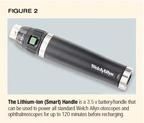
The list price for the battery/handle and charging module is $265, but most distributers will sell them for less than $200. By the end of the year a new "rapid charger base" will be available to recharge the battery/handle in seven hours, less than half the time required to recharge with the standard charger base. The rapid charger base and battery/handle combination will list for $349.
A new electronic stethoscope
Also new from Welch Allyn is the Meditron Electronic Stethoscope, which employs a patented sound-sensing technology designed to enhance clarity and has a volume control dial and a three-position frequency control dial. It is powered by lithium watch batteries that last for one to two years.
I've been using the stethoscope for several weeks and have been impressed with the clarity of the sounds transmitted by the device as well as its portability. A sound blocking feature prevents transmission of overly loud sounds to protect the hearing of the user.
The stethoscope can serve as a teaching tool when a "distributor" unit is attached to the device, allowing students to auscultate along with the examiner while wearing headphones. Best of all, the system comes with PCbased software that allows capture and storage of the auscultated sounds as wav files, which can be e-mailed to colleagues or viewed as charts and graphs. The stethoscope retails for $395, the software and PC interface is $450, and the distributor unit sells for $500. Each headphone costs $125.
Cerumen be gone
Sometimes the simplest tools prove to be the most enduring. For more than 14 years Bionix Development Corporation has been manufacturing disposable cerumen curettes to help in visualizing the tympanic membrane. Bionix recently expanded its Safe Ear Currette product line to include six types of disposable curettes designed for different purposes (Figure 3).
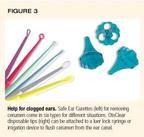
The FlexLoop is a standard, all-purpose curette that can be used for most patients. The InfantScoop is designed for use on smaller ears. The VersaLoop has a smooth flexible tip that improves user control. The AngleLoop and MicroLoop are for use with tough impacted cerumen, and the CeraSpoon is designed to help remove softer wax. The VersaLoop, MicroLoop, and InfantScoop are small enough to be used through an otoscope. The curettes sell for $42 for a box of 50.
Bionix has also introduced the OtoClear disposable tip, which can be attached to either a luer lock syringe or an irrigation device to remove cerumen from the ear canal with water (Figure 3). The OtoClear's flared design prevents overinsertion and directs water toward the walls of the ear canal, virtually eliminating the risk of damage to the tympanic membrane. The tip also has large exit portals to control backsplash and deliver effluent into the irrigation basin. OtoClear tips cost $45 for a box of 40.
They can be used with a new WaterPik device sold by Bionix for $49.95 or Bionix's own new portable handheld irrigation device called the Biocare, which sells for $99. The Biocare resembles an electric toothbrush. The OtoClear tip is attached to the unit, and a 205-mL reservoir is filled with lukewarm water. The tip is then placed in the external ear canal and a button pressed to provide a gentle lavage. A recharging stand keeps the unit ready for use.
Another new product from Bionix is the TruLine Wound Closure Forceps (Figure 4). The disposable plastic forceps is designed to help approximate wound edges when closing a laceration with tissue adhesive. Three models are available with varying tip designs for closing different size wounds. They sell for $37.50 for a box of 10.
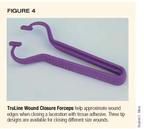
The better to see you with
Sabre Medical has produced a line of affordable, portable lighting products worth your consideration. The Sabre All-in-One Otoscope weighs just 5 oz yet provides 6,000 candle power illumination from a xenon light source (Figure 5). It is powered by two AAA batteries. It accepts standard otoscope specula and includes a side vent for pneumatic otoscopy. Available in a variety of colors, the otoscope sells for $59.95 and comes with a spare bulb, a transilluminator, two attachable cerumen loops that illuminate the ear canal during use, and a lifetime warranty. The unit is watertight to 500 feet.

A SureClean Cerumen Kit that features a light source with a clear lens and two cerumen loops of different sizes is also available from Sabre for $39.95 (Figure 5). Cerumen loops of various sizes are sold separately.
The Got-It! Sabre Eye Care Kit, includes a 4,000 candle power light source fitted with a cobalt blue lens. When used with fluorescein stain, the device reveals corneal abrasions (Figure 6). The kit also includes a loop and a magnet stem for removing conjunctival foreign bodies. It sells for $49.95. Both the Got-It! Eye Care Kit and the All-In-One Otoscope can be purchased for $90.

Sabre Medical also sells an EZ Headlight that is ideal for laceration repair, oral and nasal exams, and dermatologic and gynecologic exams. The $50 device has a 8,000 candle power xenon lamp that does not generate heat, a soft cotton headband with Velcro fastener, and a position swivel that allows the light to be manipulated easily. It is powered by two AAA batteries.
New rapid optical immunoassays
About seven years ago, Biostar of Boulder, CO, introduced a revolutionary antigen detection technology, called optical immunoassay (OIA) for diagnosing Group A streptococcus. The OIA's high sensitivity and specificity made it possible to perform an office rapid strep assay without doing a backup throat culture for negative tests. Biostar has since expanded its OIA product line.
In brief, optical immunoassay technology is based on the fact that the presence of antigen-antibody complexes on a molecular thin film affect the film's appearance when it reflects light. A test surface without antigen-antibody complex appears gold to the eye because of the refractive index of the coatings. When the test surface is thickened with antigen-antibody complex, the refractive index changes, turning the color to purple. The OIA is extremely sensitive because it requires much less antigen in the specimen to produce a visible positive compared to traditional enzyme immunoassays (EIAs).
All OIAs are classified as moderately complex tests under the Clinical Laboratory Improvement Amendments (CLIA). The Strep A test procedure takes about five minutes from start to finish and costs anywhere from $5 to $7 per test, depending on the quantity purchased.
Biostar's new tests include the FLU OIA for influenza A or B nucleoprotein antigen in throat swabs, nasopharyngeal swabs, nasal aspirates, or sputum. The sensitivity of the test is reportedly comparable to a 14-day culture, but results are available in 15 minutes. Each test costs $16.50. The tests are sold in packages of 30 kits.
Pediatricians who practice adolescent medicine may be interested in the Biostar Chlamydia OIA, which rapidly detects Chlamydia antigen from endocervical swabs. Each assay takes about 30 minutes to perform and costs about $15 per test.
Biostar's newest OIA, CdTOX A, is a test for Clostridium difficile toxin A in stool specimens. C difficile is a common nosocomial enteric bacterial pathogen that is often associated with antibiotic use. The spectrum of illness caused by C difficile ranges from mild diarrhea to pseudomembranous colitis. Toxin A is thought to be the mediator of symptoms. The OIA involves loading a sampling brush with specimen and performing a short extraction step before the test. Results are available in 10 minutes, compared to two to four hours for lab-based EIA methods or days for culture. The assay costs $15 per test and is available in packages of 30.
Intraosseous infusion for adolescents
Pediatricians trained in pediatric advanced life support (PALS) should be more than familiar with the use of intraosseous (IO) infusion as an alternative to intravenous fluid resuscitation in children under 6 years of age. Medication and volume expanders typically administered intravenously can be given by the IO route with equal efficacy. After a child is 5 or 6 years of age, however, the typical sites for insertion of IO needles, the distal femur or proximal tibia, become inaccessible because of bone density changes. Pyng Medical has developed an IO system, called the F.A.S.T.1, to rapidly insert an IO line in the sternal manubrium of adults and adult-size (adolescent) patients.
The system consists of an infusion tube (a clear flexible tube with a stainless steel bone portal tip fitted with a luer connection), introducer, protector dome, target patch, and remover. After the area is prepped with alcohol, the index finger is used to align the target patch with the patient's sternal notch, and the introducer is placed in the target zone of the patch, perpendicular to the skin. A push on the introducer inserts the infusion tube into the marrow space of the sternal manubrium.
When the introducer is removed, the infusion tube and a two-part support sleeve fall away. The fluid source is attached, and the protector dome is pressed down over the target patch to engage a Velcro ring, which secures the infusion system in place. The system requires no further stabilization during use and transport, and its position will not interfere with CPR. Most users find that with a little practice they can establish a F.A.S.T.1 line in a minute or less.
The single-use, disposable system costs about $98. Pyng Medical expects to begin developing a similar system for rapidly establishing IO lines in infants soon.
No more needle sticks
Transmission of blood-borne pathogens continues to be a concern for office physicians and nurses, who administer dozens of immunizations a day. Needle-stick injuries are a risk we all try to avoid. New Medical Technology has introduced a new retractable Safety Syringe that virtually foolproofs the injection technique (Figure 7). The latex-free syringe sells for 50 cents (about twice the cost of typical syringes).
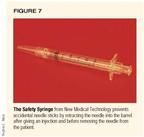
The syringe is filled in the standard manner, and air is expelled. After an intramuscular or subcutaneous injection is administered, and before removing the needle from the patient, the plunger is fully depressed. This maneuver retracts the needle into the barrel, making a needle stick impossible. Very neat item.
Monitoring blood glucose without finger sticks
In the not-too-distant future we can look forward to noninvasive technologies for the transcutaneous assay of serum glucose.3 In the meantime, a new glucose analyzer for office or home use by diabetic patients facilitates blood glucose measurements without painful finger sticks. The AtLast Blood Glucose System from Amira Medical combines an analyzer with a specimen acquisition system in a compact, affordable device (Figure 8).
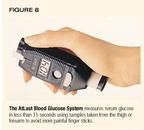
The monitor is fitted with a test strip and lancet prior to use. The patient positions it against either the forearm or thigh, and, using a press-and-release motion, activates the lancet to draw blood to the surface. A test strip in the top of the device is touched to the blood sample, and the specimen is drawn into the unit by capillary action. Results are displayed in less than 15 seconds. The thigh or forearm are ideal sites for specimen collection because they are less sensitive to pain than the fingertips.
The AtLast system is available either online or at pharmacies and retails for $63. Lancets cost $8 for a box of 100, and test strips retail for $37 for a box of 50.
Welcome to the futurebecoming a digital pediatrician
I began this year by discussing developing technologies that will change the way we practice medicine.3 In the future chances are good that medications such as insulin, morphine, and interferon will be delivered by inhalation, many blood chemistry tests will be performed transcutaneously, and immunizations will be administered by nasal sprays or foodstuffs. Aroma scanning technology that is now in development will facilitate early detection of bacterial infections using sensors that literally "smell" for evidence of bacterial growth.
As exciting as these prospects are, true advances in pediatric practice will come from technologies that improve the ways we document patient visits, track tests, generate prescriptions, and arrange referrals in the complex and confusing environment of managed care. I am convinced that this can and will be achieved by the convergence of handheld devices, electronic medical record (EMR) systems (also called computerized patient medical records), and wireless technology. I am pleased to report that these technologies are becoming more sophisticated and affordable all the time.
For several years physicians have been using the popular Palm Pilot to store patient and pharmacy contact information, look up drug information, and even record visit notes. While I have been a big fan of the Palm Pilot, the new generation of Windows CE Pocket PCs (Casio's Cassiopeia, Compaq's IPAQ, and Hewlett-Packard's Jordada) has surpassed the Palm Pilot in features and ease of use. Medical applications for these devices are rapidly becoming available.
Pocket PCs feature backlit color screens, voice recording, expedited note writing with optical character recognition (capable of converting even our sloppy handwriting into legible text) and the ability to synchronize this information with a desktop computer. Price tags for the devices begin at $400, and most can be equipped with modems, wireless transmitters, and extra memory.
A new Internet-based resource, Handheldmed, provides a service called MobilePractice, for either your Palm Pilot or Pocket PC. For a subscription that costs $180 per year you can download more than 60 licensed titles from their "PocketClinician" library, including the Merck Manual, NeoFax, the Physician Drug Handbook, The Common Symptom Guide, Principles of Critical Care, and others. By the time you read this the Red Book and Harriet Lane Handbook should also be available. In my experience it's been a great time saver to have a resource library that you can hold in your hand and navigate with simple search screens.
A Handheldmed subscription also entitles physicians to download and use a Pocket PC application called Patient Tracker. Patient Tracker lets you record a brief office or hospital note that includes patient history, vital signs, and lab and test results and to produce a printout by beaming the information to a printer equipped with an infrared port.
Another excellent medical resource for use with personal digital assistants is Skyscape, which offers complete adult and pediatric drug databases, called Lexidrugs, for both the Palm and Pocket PC platforms. They provide quick access to appropriate dosages, preparations, side effects, and drug interactions. At $65 each, the databases are quite affordable.
A prescription writing service called iScribe is now available throughout the country. When you enroll in iScribe, a free pocket PC with preinstalled iScribe software and an infrared printer are delivered to your office. Daily patient lists from your billing software are downloaded into the pocket PC so that the iScribe software can quickly generate prescriptions during patient visits. The prescription is transmitted to the printer and then handed to the patient. In the future prescriptions will be delivered electronically or by fax directly to the patient's pharmacy.
CompuKID: Tomorrow's office management today
Dan Freiling is an experienced computer programmer who had the good fortune to marry a pediatrician. He knew that pediatric practices desperately needed a better way to document visits, create legible chart notes, track immunizations, and educate parentsand he knew that computer software could achieve this goal. His brainchilda combination of pediatric electronic toolkit and electronic medical record called CompuKIDwas released six years ago as a DOSbased program for PCs. It is now one of the most popular EMR systems for pediatric practices with more than 200,000 visits and 500,000 immunizations documented.

Freiling boasts that physicians who use CompuKID have received perfect scores when audited by insurance companies, no small achievement. CompuKID has been renamed e-CompuKID and is now being transformed into the pediatric practice management program that we all dream of.
Fewer than 5% of physicians use EMRs because they have been prohibitively expensive. It is not unusual for initial installation, including hardware and software, to cost more than $20,000 to $25,000. Current primary care EMR systems require a hardwired computer network, and practices must continue to use a separate billing program. The new e-CompuKID is a wireless, Internet-based practice management system that integrates an EMR with a billing program, patient scheduler, word processor, drug database, prescription software, and an accounting program.
The heart of the system is a single Internet-connected PC outfitted to support a wireless network. Nurses and doctors use sturdy, portable, large-screen, Windows CEbased, solid-state handhelds that all share the same information across the network. Users can enter information with a stylus on a touchscreen or a traditional keyboard.
Here is how it works: When a parent and child enter the office, the receptionist updates her computer to ensure that all information is current and indicate that the patient is ready to be seen. The nurse brings the child back to the exam room, takes vital signs, and records a nursing note on the handheld. When the nurse is finished, an electronic flag appears on the physician's handheld. When the doctor enters the room to do the interview and exam, all active problems, medications, and recent tests are readily available on quick-view screens. Inputting the office note and updating the patient's problem list on the handheld takes a fraction of the time it would take to write an illegible note.
The physician can quickly generate school forms, prescriptions, instruction sheets, lab or X-ray request forms, and a printed note for the chart record along with a superbill. Best of all, the appropriate forms and requests can be sent electronically wherever they need to gothe pharmacy, school, insurance company, consulting physician, and so on.
All information in the system is archived over the Internet on the e-CompuKID servers. This means that the integrated program modules can be upgraded without a technician visiting the office to install software and all information is secure. Such a system expedites reimbursement because data is transferred seamlessly to the integrated billing program, which files an automatic electronic claim for services upon completion of the visit. The information can be accessed anywhere there is a PC connected to the Internetoffice, home, hospital, or on the road via a wireless Internet device. The program also makes it possible for support staff (such as your biller) to work in the comfort of home.
Perhaps what is most exciting about this extremely capable system is its cost. An office can be equipped with the e-CompuKID Management Suite with several computers, scanner, printers (for receptionist, biller, and physician), and handhelds (for nurse and physician) for an introductory price of $3,500 plus a monthly fee of around $400 per physician per month.
Never better
Technology in the trenches of pediatric care has never been better. The new products discussed here are worth trying, and some of them just might change the way you and I practice office pediatrics. Present and developing technologies will undoubtedly improve our access to important medical resources and patient information and facilitate the process of caring for our patients. See you in the 21st century.
For more information
ERO-SCAN Otoacoustic Emission Test System
Maico Diagnostics
9675 West 76th Street
Eden Prairie, MN 55344
888-941-4201
www.maico-diagnostics.com
Visual Red Book on CD-ROM
The American Academy of Pediatrics
141 Northwest Point Boulevard
Elk Grove Village, IL 60007-1098
800-433-9016
www.aap.org
Lithium-Ion (Smart) Handle and AC charging moduleMeditron Electronic Stethoscope
Welch Allyn Medical Products
4341 State Street Road
PO Box 220
Skaneateles Falls, NY 13153-0220
800-535-6663
www.welchallyn.com
Safe Ear CurrettesOtoClear irrigation tipBiocare irrigation deviceTruLine Wound Closure Forceps
Bionix Development Corporation
5154 Enterprise Boulevard
Toledo, OH 43612
800-551-7096
www.bionixusa.com.
Optical immunoassays
Biostar, Inc.
6655 Lookout Road
Boulder, Colorado 80301
800-637-3717
www.biostar.com
F.A.S.T.1 Intraosseous Infusion System
Pyng Medical Corp.
#260-13155 Delf Road
Richmond, BC
Canada, V6V 2A2
604-303-7964
www.pyng.com
All-in-One OtoscopeGot-It! Eye Care KitSureClean Cerumen KitEZ Headlight
Sabre Medical Instruments
29 Hudson Road, Suite 5
Sudbury, MA 01776
888-731-2327
www.sabremedical.com
NMT Safety Syringe
New Medical Technology, Inc.
1500 West Oak Street
Suite 200
Zionsville, IN 46077
800-522-1512
www.new-medical-technology.com
AtLast Blood Glucose System
Amira Medical
4742 Scotts Valley Drive
Scotts Valley, CA 95066
877-264-7263
www.amiramed.com
MobilePracticePatient Tracker
Handheldmed, Inc.
PO Box 435
Springboro, Ohio 45066
918-584-2294
www.handheldmed.com
Lexidrugs
Skyscape.com, Inc.
131 Coolidge Street
Suite 222
Hudson, MA 01749
888-759-7227
www.skyscape.com
iScribe prescription service
iScribe, Inc.
155 Bovet Road, Suite 300
San Mateo, CA 94402
877-771-4900
www.iscribe.com
e-CompuKID
e-Medrecords, Inc.
37 Summertree Run
Sparta, NJ 07871
800-935-5244
www.e-medrecords.com
REFERENCES
1. American Academy of Pediatrics Joint Committee on Infant Hearing: Joint Committee on Infant Hearing 1994 position statement. Pediatrics 1995;95(1):152
2. Combs JT, Schuman AJ: Three technologies for taming otitis media. Contemporary Pediatrics 1999;16(3):78
3. Schuman AJ: Beyond 2000: Tomorrow's office technologies today. Contemporary Pediatrics 2000;17(1):116
THE AUTHOR is Adjunct Assistant Professor of Pediatrics at Dartmouth Medical School, Lebanon, NH, and practices pediatrics at Hampshire Pediatrics, Manchester, NH. He is a Contributing Editor for Contemporary Pediatrics.
Andrew Schuman. New Products for pediatricians: 2000. Contemporary Pediatrics 2000;12:41.
Recognize & Refer: Hemangiomas in pediatrics
July 17th 2019Contemporary Pediatrics sits down exclusively with Sheila Fallon Friedlander, MD, a professor dermatology and pediatrics, to discuss the one key condition for which she believes community pediatricians should be especially aware-hemangiomas.
Itchy skin associated with sleep problems in infants
September 27th 2024A recent study presented at the American Academy of Pediatrics 2024 National Conference & Exhibition, sheds light on the connection between skin conditions and sleep disturbances in infants and toddlers, highlighting itchy skin as a significant factor, even in the absence of atopic